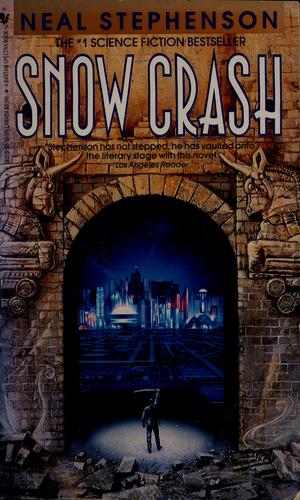m040601 reviewed Snow Crash by Neal Stephenson (A Bantam spectra book)
my review of snow crash
2 stars
This book is fyne

470 pages
English language
Published Aug. 13, 1993 by Bantam Books.
Within the Metaverse, Hiro is offered a datafile named Snow Crash by a man named Raven who hints that it is a form of narcotic. Hiro's friend and fellow hacker Da5id views a bitmap image contained in the file which causes his computer to crash and Da5id to suffer brain damage in the real world.
This is the future we now live where all can be brought to life in the metaverse and now all can be taken away. Follow on an adventure with Hiro and YT as they work with the mob to uncover a plot of biblical proportions.
Within the Metaverse, Hiro is offered a datafile named Snow Crash by a man named Raven who hints that it is a form of narcotic. Hiro's friend and fellow hacker Da5id views a bitmap image contained in the file which causes his computer to crash and Da5id to suffer brain damage in the real world.
This is the future we now live where all can be brought to life in the metaverse and now all can be taken away. Follow on an adventure with Hiro and YT as they work with the mob to uncover a plot of biblical proportions.
This book is fyne
TL;DR
This book interrogates a comical and whimsical representation of post-collapse neofeudalism. It's relevant in 2025, but there is not enough substance to be a suggested read.
Review
I wouldn't agree with bookwyrm.social/user/nixnull/review/3404846#anchor-3404846 review which says that it's "nearly perfect". The writing is quite pretentious, but it doesn't feel to me that this book was edited as it had some sentences where the words would repeat within them, ruining the smooth feel of reading some other bits.
The book is not serious at all. It's speculative humorous sci-fi. It has plot and smart twists that a careful reader will see from a mile away and then feel smart about it.
The world-building is very solid, but extremely postmodernist, thus devoid of real philosophy, just cute mental experiments of the author mashed together in an eclectic mash.
It's quotable but insensitive, written with implied white …
TL;DR
This book interrogates a comical and whimsical representation of post-collapse neofeudalism. It's relevant in 2025, but there is not enough substance to be a suggested read.
Review
I wouldn't agree with bookwyrm.social/user/nixnull/review/3404846#anchor-3404846 review which says that it's "nearly perfect". The writing is quite pretentious, but it doesn't feel to me that this book was edited as it had some sentences where the words would repeat within them, ruining the smooth feel of reading some other bits.
The book is not serious at all. It's speculative humorous sci-fi. It has plot and smart twists that a careful reader will see from a mile away and then feel smart about it.
The world-building is very solid, but extremely postmodernist, thus devoid of real philosophy, just cute mental experiments of the author mashed together in an eclectic mash.
It's quotable but insensitive, written with implied white male privilege and contains a scene that no male should have written.
The book is too long, but at no point I felt like it's dragging too much. If you are as weird as me and would enjoy reading a three-page vignette about toilet paper dispensing in an office building, you won't mind either even though it's quite weird. Douglas Adams would have condensed these three pages into a single sentence because he had a true handle on the language and pace.
I give this 3.75 stars with the hope that Stephenson wasn't serious.
I will probably give him another chance to see if 7 years of learning how to write had a positive impact by the time he released his most impactful work, "Cryptonomicon".
Obligatory quote of the book:
The byproduct of the lifestyle is polluted rivers, greenhouse effect, spouse abuse, televangelists, and serial killers. But as long as you have that four-wheel-drive vehicle and can keep driving north, you can sustain it, keep moving just quickly enough to stay one step ahead of your own waste stream.
Not bad for 1992. It is so ironic that folks like jeffery bezos and other post-capitalism oligarchs decided that it's a blueprint for action rather than a warning. It's even more ironic that Mr. Stephenson decided that it's a great idea to work for bezos later in his life. I guess some people really want to live in neofeudalism, so aptly described in Snow Crash?..
This is the world of Snow Crash. The Feds won't help you. They're a much weaker clave. If you're in Bob Rife's employ, he claims ownership of your brain.
This is the world of Snow Crash. The Feds won't help you. They're a much weaker clave. If you're in Bob Rife's employ, he claims ownership of your brain.
An absolute classic masterpiece of cyberpunk with social commentary and themes just as relevant today as when it was written. Marred by its creepy obsession with a 15 year old character.
For all the high-flying cyberpunk action, my favorite parts were the conspirasist digressions on ancient linguistics.
One of my all-time favorites (although not quite my favorite Neal Stephenson book, that would be The Diamond Age), I read this way back when, and it's held up over time and many rereadings. If I'm wandering a bookshop and don't see anything that grabs me, I'll just get another copy of this book. It's a fun, zippy read (not as epic an undertaking as his later 500+ page behemoths), and its metaverse still sparks the imagination more than the present-day Meta metaverse. The characters are all great, but for emotional depth, I'm going with the Rat Thing.
One of my all-time favorites (although not quite my favorite Neal Stephenson book, that would be The Diamond Age), I read this way back when, and it's held up over time and many rereadings. If I'm wandering a bookshop and don't see anything that grabs me, I'll just get another copy of this book. It's a fun, zippy read (not as epic an undertaking as his later 500+ page behemoths), and its metaverse still sparks the imagination more than the present-day Meta metaverse. The characters are all great, but for emotional depth, I'm going with the Rat Thing.
I've read this a few times over the years and It holds up. Interesting to see many things in the tech landscape emerge that hark to this book. Also fun to see what didn't launch into our lives no matter how hard the tech bros tried to make it happen. Maybe in another 20 years.
I've read this a few times over the years and It holds up. Interesting to see many things in the tech landscape emerge that hark to this book. Also fun to see what didn't launch into our lives no matter how hard the tech bros tried to make it happen. Maybe in another 20 years.
Wonderful classic with both action and philosophical depth
the opening is one of the best things I've ever read, ever. huge shame that it fails to maintain the momentum for long long periods. hugely flawed but extremely entertaining
the opening is one of the best things I've ever read, ever. huge shame that it fails to maintain the momentum for long long periods. hugely flawed but extremely entertaining
A little difficult to get into at the start, turned a corner sharply and hooked me right to the end. An interesting use of ideas surrounding the history of language, of virtual and physical viruses, and the ‘metaverse’ seeing it’s first outing (before Facebook borrowed the name) - and a pair of protagonists who you find yourself desperately hoping will get to the source of the problem.
A little difficult to get into at the start, turned a corner sharply and hooked me right to the end. An interesting use of ideas surrounding the history of language, of virtual and physical viruses, and the ‘metaverse’ seeing it’s first outing (before Facebook borrowed the name) - and a pair of protagonists who you find yourself desperately hoping will get to the source of the problem.
I’m not sure why I had never read this book. It was in the back of my mind for years as something I should read. I heard Stephenson in an interview discussing the 30th anniversary of its publication and decided it was time. I’m so glad I did.
If there’s one thing I love in a book, it is an authentic voice. Something the author is wholly committed to, and is not quite like anything else. If you’d like to know if this novel’s voice will appeal to you, just read the first chapter. It’s only a dozen pages, and it’s a whirlwind.
I really enjoyed the premise of this fictional universe. It was imaginative, slightly deranged, and steeped in history, linguistics, and computer programming—all things I love. If you want to pick on the book, it is definitely “tell-y”. You’ll find long chapters where the protagonist …
A defining book of the cyberpunk genre, I enjoyed reading this novel thoroughly. Although captivating, the occasional bursts of lore explanation introduced just a little hint of boredom to my reading experience. Additionally, I was often left confused (not the good kind) about some plot elements, with this confusion only being alleviated a few chapters later. Despite these hardships, I still loved Snow Crash, and I recommend it to anybody interested in cyberpunk or dystopian science fiction.
P.S.: Raven is weird as fuck.
Just re-read this book, and it's amazing how prescient Stephenson was in 1992. Re-reading gave me a strange combination of nostalgia, hope and fear of how technology can be used. The wide-open possibilities of the early net have been largely foreclosed by commercial interests, but the current implosion of Tw*tter and growing awareness of the dangers of siloed spaces may be creating a renaissance of DIY, distributed and free (as in speech) media. Or it could still move into the hypercapitalist hellscape of Snow Crash. The power is in our hands.
(re-post for experimental reasons)
Just re-read this book, and it's amazing how prescient Stephenson was in 1992. Re-reading gave me a strange combination of nostalgia, hope and fear of how technology can be used. The wide-open possibilities of the early net have been largely foreclosed by commercial interests, but the current implosion of Tw*tter and growing awareness of the dangers of siloed spaces may be creating a renaissance of DIY, distributed and free (as in speech) media. Or it could still move into the hypercapitalist hellscape of Snow Crash. The power is in our hands.
(re-post for experimental reasons)
Just re-read this book, and it's amazing how prescient Stephenson was in 1992. Re-reading gave me a strange combination of nostalgia, hope and fear of how technology can be used. The wide-open possibilities of the early net have been largely foreclosed by commercial interests, but the current implosion of Tw*tter and growing awareness of the dangers of siloed spaces may be creating a renaissance of DIY, distributed and free (as in speech) media. Or it could still move into the hypercapitalist hellscape of Snow Crash. The power is in our hands.
Just re-read this book, and it's amazing how prescient Stephenson was in 1992. Re-reading gave me a strange combination of nostalgia, hope and fear of how technology can be used. The wide-open possibilities of the early net have been largely foreclosed by commercial interests, but the current implosion of Tw*tter and growing awareness of the dangers of siloed spaces may be creating a renaissance of DIY, distributed and free (as in speech) media. Or it could still move into the hypercapitalist hellscape of Snow Crash. The power is in our hands.


























































































































































































































































